Innovation & Change: Business Environment Analysis
VerifiedAdded on 2023/01/23
|17
|4444
|86
AI Summary
This article discusses the business environment analysis of Changi Airport in Singapore, including SWOT analysis, PESTEL analysis, and comparison with other airports. It also explores the effective change management strategies implemented by Changi Airport.
Contribute Materials
Your contribution can guide someone’s learning journey. Share your
documents today.
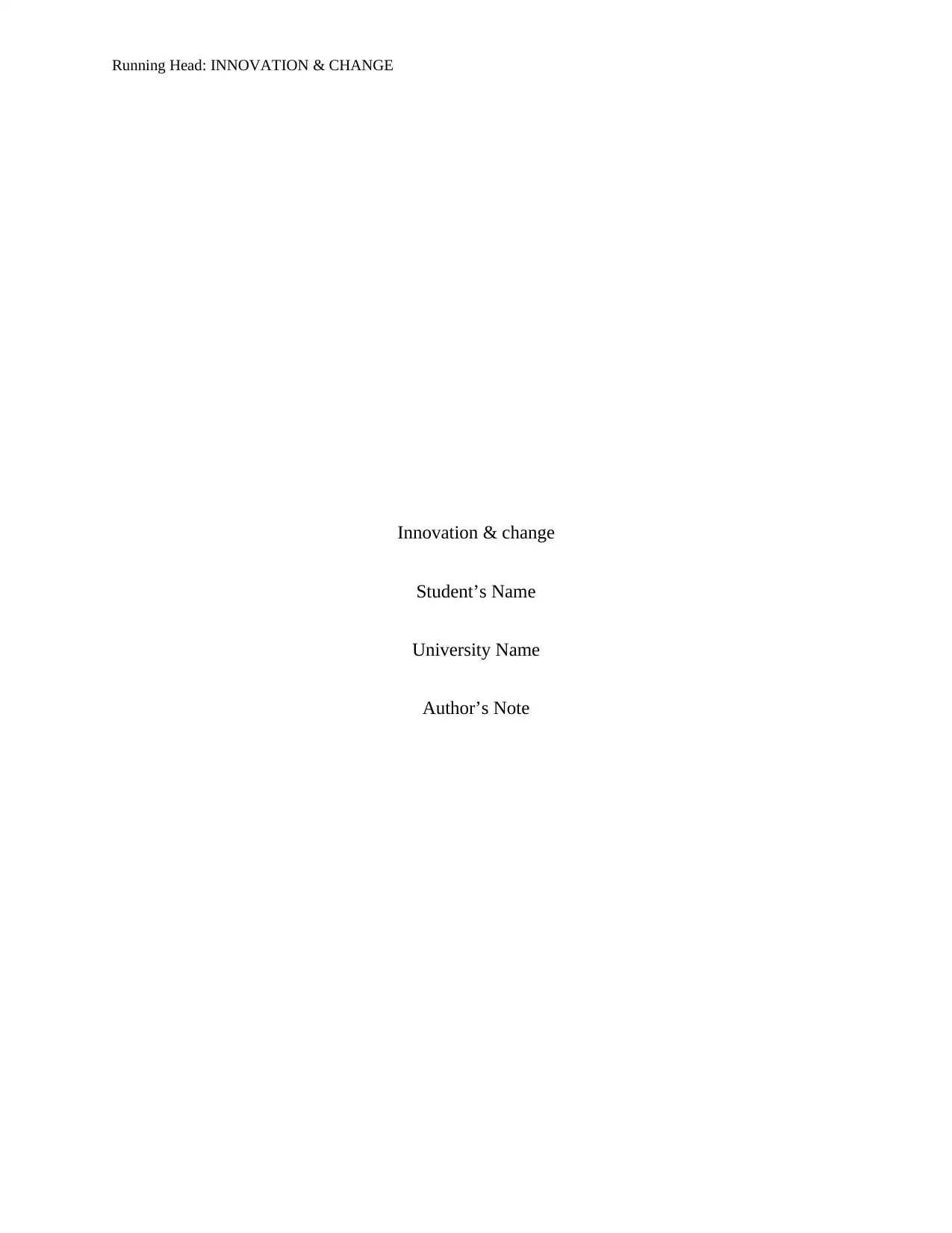
Running Head: INNOVATION & CHANGE
Innovation & change
Student’s Name
University Name
Author’s Note
Innovation & change
Student’s Name
University Name
Author’s Note
Secure Best Marks with AI Grader
Need help grading? Try our AI Grader for instant feedback on your assignments.
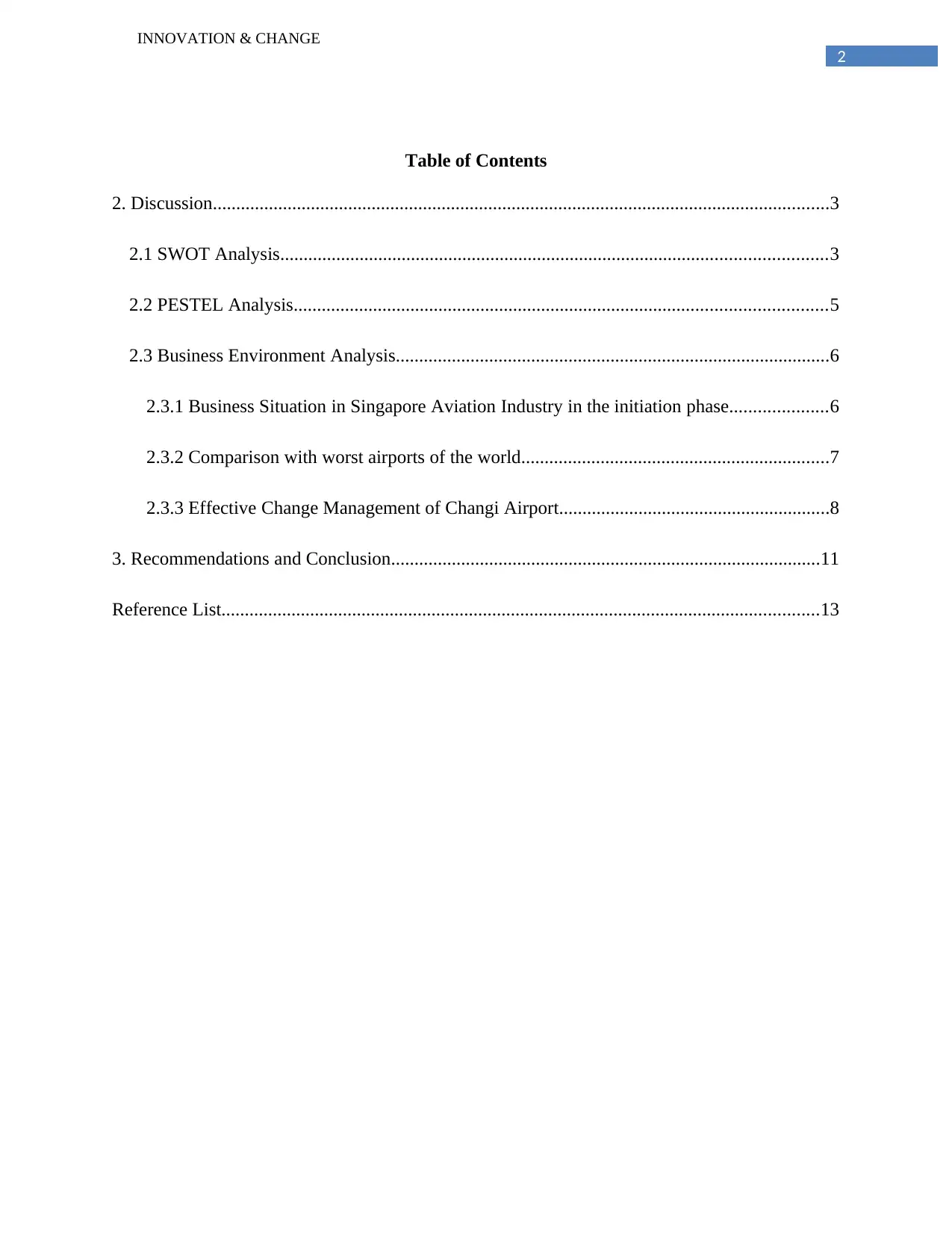
2
INNOVATION & CHANGE
Table of Contents
2. Discussion....................................................................................................................................3
2.1 SWOT Analysis.....................................................................................................................3
2.2 PESTEL Analysis..................................................................................................................5
2.3 Business Environment Analysis.............................................................................................6
2.3.1 Business Situation in Singapore Aviation Industry in the initiation phase.....................6
2.3.2 Comparison with worst airports of the world..................................................................7
2.3.3 Effective Change Management of Changi Airport..........................................................8
3. Recommendations and Conclusion............................................................................................11
Reference List................................................................................................................................13
INNOVATION & CHANGE
Table of Contents
2. Discussion....................................................................................................................................3
2.1 SWOT Analysis.....................................................................................................................3
2.2 PESTEL Analysis..................................................................................................................5
2.3 Business Environment Analysis.............................................................................................6
2.3.1 Business Situation in Singapore Aviation Industry in the initiation phase.....................6
2.3.2 Comparison with worst airports of the world..................................................................7
2.3.3 Effective Change Management of Changi Airport..........................................................8
3. Recommendations and Conclusion............................................................................................11
Reference List................................................................................................................................13
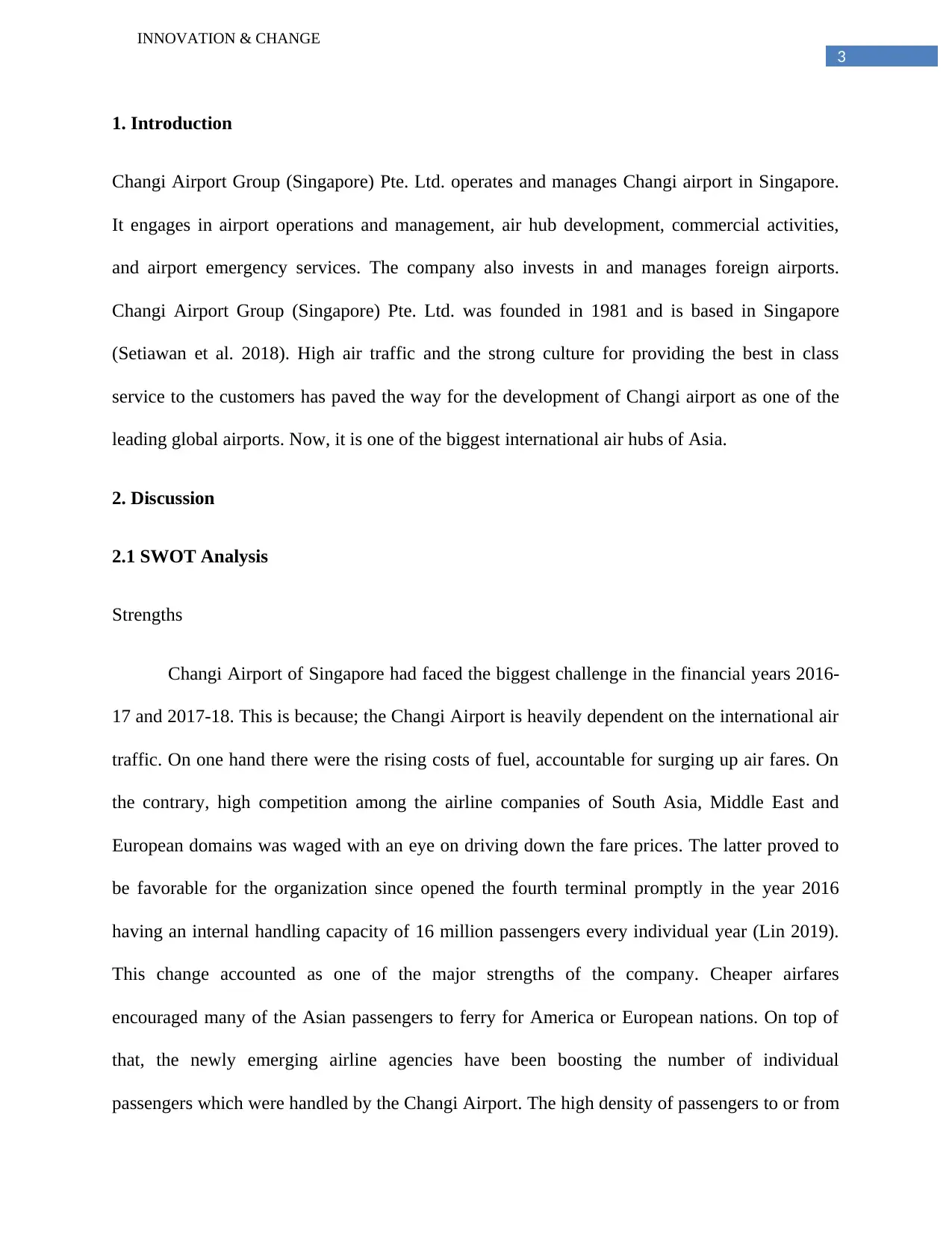
3
INNOVATION & CHANGE
1. Introduction
Changi Airport Group (Singapore) Pte. Ltd. operates and manages Changi airport in Singapore.
It engages in airport operations and management, air hub development, commercial activities,
and airport emergency services. The company also invests in and manages foreign airports.
Changi Airport Group (Singapore) Pte. Ltd. was founded in 1981 and is based in Singapore
(Setiawan et al. 2018). High air traffic and the strong culture for providing the best in class
service to the customers has paved the way for the development of Changi airport as one of the
leading global airports. Now, it is one of the biggest international air hubs of Asia.
2. Discussion
2.1 SWOT Analysis
Strengths
Changi Airport of Singapore had faced the biggest challenge in the financial years 2016-
17 and 2017-18. This is because; the Changi Airport is heavily dependent on the international air
traffic. On one hand there were the rising costs of fuel, accountable for surging up air fares. On
the contrary, high competition among the airline companies of South Asia, Middle East and
European domains was waged with an eye on driving down the fare prices. The latter proved to
be favorable for the organization since opened the fourth terminal promptly in the year 2016
having an internal handling capacity of 16 million passengers every individual year (Lin 2019).
This change accounted as one of the major strengths of the company. Cheaper airfares
encouraged many of the Asian passengers to ferry for America or European nations. On top of
that, the newly emerging airline agencies have been boosting the number of individual
passengers which were handled by the Changi Airport. The high density of passengers to or from
INNOVATION & CHANGE
1. Introduction
Changi Airport Group (Singapore) Pte. Ltd. operates and manages Changi airport in Singapore.
It engages in airport operations and management, air hub development, commercial activities,
and airport emergency services. The company also invests in and manages foreign airports.
Changi Airport Group (Singapore) Pte. Ltd. was founded in 1981 and is based in Singapore
(Setiawan et al. 2018). High air traffic and the strong culture for providing the best in class
service to the customers has paved the way for the development of Changi airport as one of the
leading global airports. Now, it is one of the biggest international air hubs of Asia.
2. Discussion
2.1 SWOT Analysis
Strengths
Changi Airport of Singapore had faced the biggest challenge in the financial years 2016-
17 and 2017-18. This is because; the Changi Airport is heavily dependent on the international air
traffic. On one hand there were the rising costs of fuel, accountable for surging up air fares. On
the contrary, high competition among the airline companies of South Asia, Middle East and
European domains was waged with an eye on driving down the fare prices. The latter proved to
be favorable for the organization since opened the fourth terminal promptly in the year 2016
having an internal handling capacity of 16 million passengers every individual year (Lin 2019).
This change accounted as one of the major strengths of the company. Cheaper airfares
encouraged many of the Asian passengers to ferry for America or European nations. On top of
that, the newly emerging airline agencies have been boosting the number of individual
passengers which were handled by the Changi Airport. The high density of passengers to or from
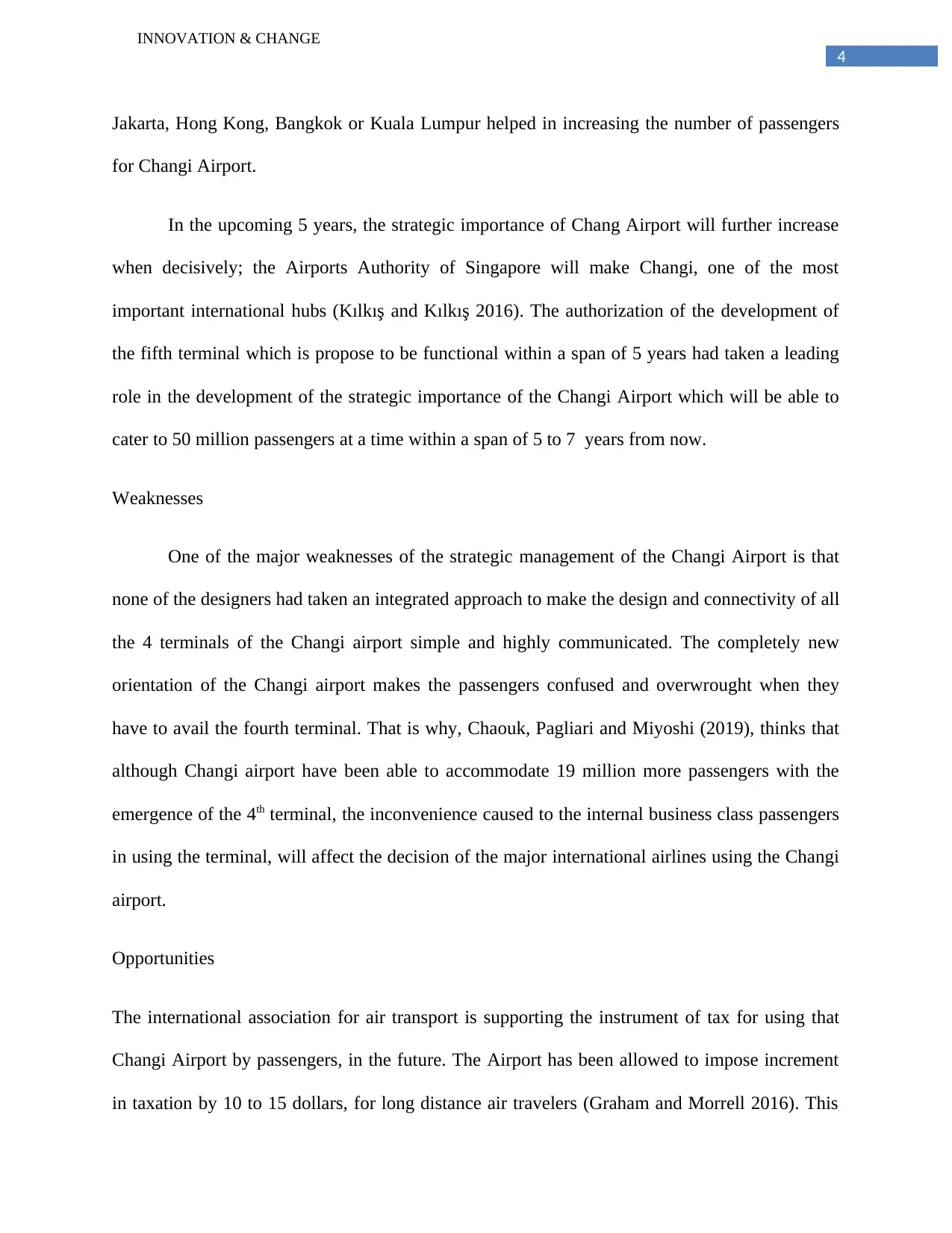
4
INNOVATION & CHANGE
Jakarta, Hong Kong, Bangkok or Kuala Lumpur helped in increasing the number of passengers
for Changi Airport.
In the upcoming 5 years, the strategic importance of Chang Airport will further increase
when decisively; the Airports Authority of Singapore will make Changi, one of the most
important international hubs (Kılkış and Kılkış 2016). The authorization of the development of
the fifth terminal which is propose to be functional within a span of 5 years had taken a leading
role in the development of the strategic importance of the Changi Airport which will be able to
cater to 50 million passengers at a time within a span of 5 to 7 years from now.
Weaknesses
One of the major weaknesses of the strategic management of the Changi Airport is that
none of the designers had taken an integrated approach to make the design and connectivity of all
the 4 terminals of the Changi airport simple and highly communicated. The completely new
orientation of the Changi airport makes the passengers confused and overwrought when they
have to avail the fourth terminal. That is why, Chaouk, Pagliari and Miyoshi (2019), thinks that
although Changi airport have been able to accommodate 19 million more passengers with the
emergence of the 4th terminal, the inconvenience caused to the internal business class passengers
in using the terminal, will affect the decision of the major international airlines using the Changi
airport.
Opportunities
The international association for air transport is supporting the instrument of tax for using that
Changi Airport by passengers, in the future. The Airport has been allowed to impose increment
in taxation by 10 to 15 dollars, for long distance air travelers (Graham and Morrell 2016). This
INNOVATION & CHANGE
Jakarta, Hong Kong, Bangkok or Kuala Lumpur helped in increasing the number of passengers
for Changi Airport.
In the upcoming 5 years, the strategic importance of Chang Airport will further increase
when decisively; the Airports Authority of Singapore will make Changi, one of the most
important international hubs (Kılkış and Kılkış 2016). The authorization of the development of
the fifth terminal which is propose to be functional within a span of 5 years had taken a leading
role in the development of the strategic importance of the Changi Airport which will be able to
cater to 50 million passengers at a time within a span of 5 to 7 years from now.
Weaknesses
One of the major weaknesses of the strategic management of the Changi Airport is that
none of the designers had taken an integrated approach to make the design and connectivity of all
the 4 terminals of the Changi airport simple and highly communicated. The completely new
orientation of the Changi airport makes the passengers confused and overwrought when they
have to avail the fourth terminal. That is why, Chaouk, Pagliari and Miyoshi (2019), thinks that
although Changi airport have been able to accommodate 19 million more passengers with the
emergence of the 4th terminal, the inconvenience caused to the internal business class passengers
in using the terminal, will affect the decision of the major international airlines using the Changi
airport.
Opportunities
The international association for air transport is supporting the instrument of tax for using that
Changi Airport by passengers, in the future. The Airport has been allowed to impose increment
in taxation by 10 to 15 dollars, for long distance air travelers (Graham and Morrell 2016). This
Secure Best Marks with AI Grader
Need help grading? Try our AI Grader for instant feedback on your assignments.
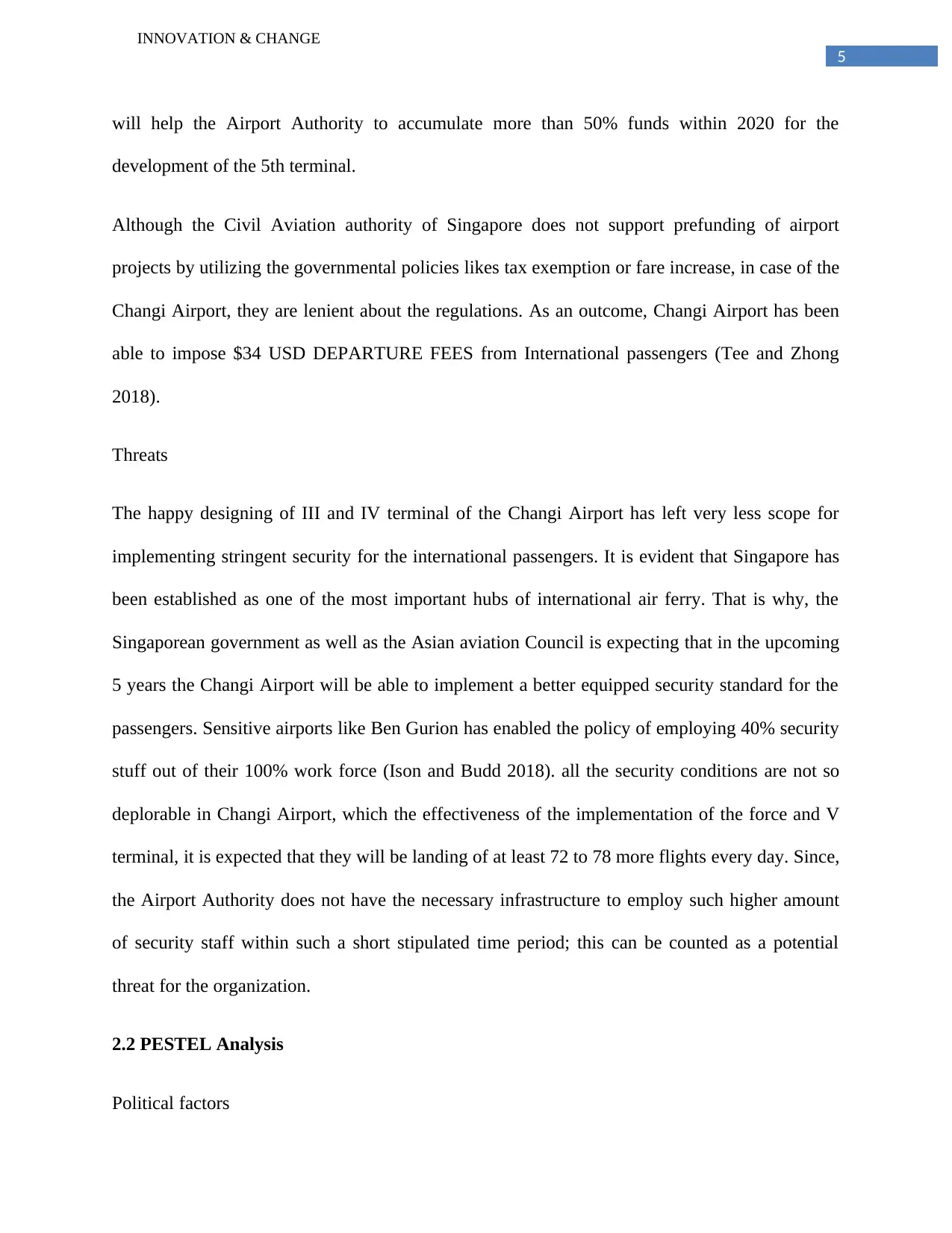
5
INNOVATION & CHANGE
will help the Airport Authority to accumulate more than 50% funds within 2020 for the
development of the 5th terminal.
Although the Civil Aviation authority of Singapore does not support prefunding of airport
projects by utilizing the governmental policies likes tax exemption or fare increase, in case of the
Changi Airport, they are lenient about the regulations. As an outcome, Changi Airport has been
able to impose $34 USD DEPARTURE FEES from International passengers (Tee and Zhong
2018).
Threats
The happy designing of III and IV terminal of the Changi Airport has left very less scope for
implementing stringent security for the international passengers. It is evident that Singapore has
been established as one of the most important hubs of international air ferry. That is why, the
Singaporean government as well as the Asian aviation Council is expecting that in the upcoming
5 years the Changi Airport will be able to implement a better equipped security standard for the
passengers. Sensitive airports like Ben Gurion has enabled the policy of employing 40% security
stuff out of their 100% work force (Ison and Budd 2018). all the security conditions are not so
deplorable in Changi Airport, which the effectiveness of the implementation of the force and V
terminal, it is expected that they will be landing of at least 72 to 78 more flights every day. Since,
the Airport Authority does not have the necessary infrastructure to employ such higher amount
of security staff within such a short stipulated time period; this can be counted as a potential
threat for the organization.
2.2 PESTEL Analysis
Political factors
INNOVATION & CHANGE
will help the Airport Authority to accumulate more than 50% funds within 2020 for the
development of the 5th terminal.
Although the Civil Aviation authority of Singapore does not support prefunding of airport
projects by utilizing the governmental policies likes tax exemption or fare increase, in case of the
Changi Airport, they are lenient about the regulations. As an outcome, Changi Airport has been
able to impose $34 USD DEPARTURE FEES from International passengers (Tee and Zhong
2018).
Threats
The happy designing of III and IV terminal of the Changi Airport has left very less scope for
implementing stringent security for the international passengers. It is evident that Singapore has
been established as one of the most important hubs of international air ferry. That is why, the
Singaporean government as well as the Asian aviation Council is expecting that in the upcoming
5 years the Changi Airport will be able to implement a better equipped security standard for the
passengers. Sensitive airports like Ben Gurion has enabled the policy of employing 40% security
stuff out of their 100% work force (Ison and Budd 2018). all the security conditions are not so
deplorable in Changi Airport, which the effectiveness of the implementation of the force and V
terminal, it is expected that they will be landing of at least 72 to 78 more flights every day. Since,
the Airport Authority does not have the necessary infrastructure to employ such higher amount
of security staff within such a short stipulated time period; this can be counted as a potential
threat for the organization.
2.2 PESTEL Analysis
Political factors
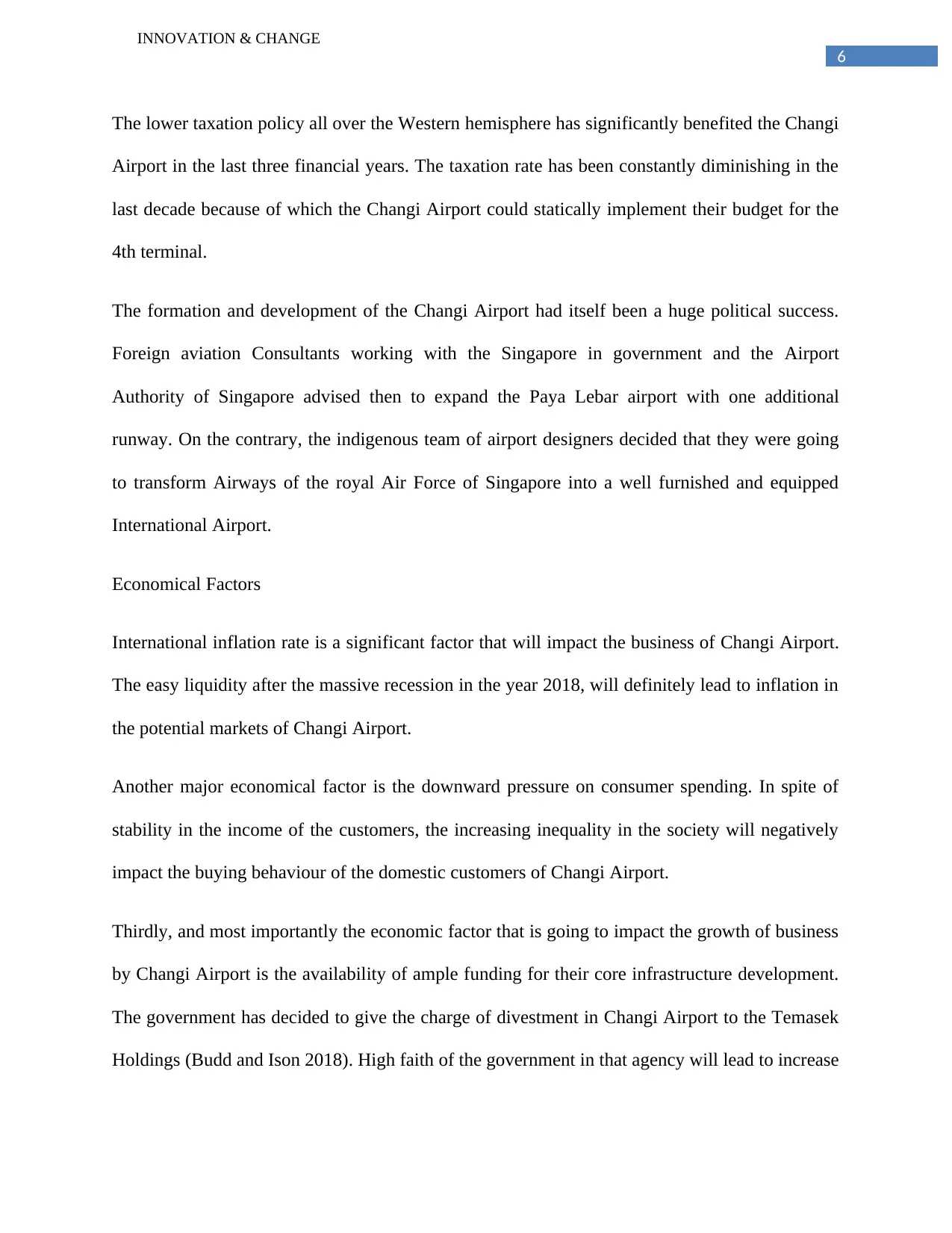
6
INNOVATION & CHANGE
The lower taxation policy all over the Western hemisphere has significantly benefited the Changi
Airport in the last three financial years. The taxation rate has been constantly diminishing in the
last decade because of which the Changi Airport could statically implement their budget for the
4th terminal.
The formation and development of the Changi Airport had itself been a huge political success.
Foreign aviation Consultants working with the Singapore in government and the Airport
Authority of Singapore advised then to expand the Paya Lebar airport with one additional
runway. On the contrary, the indigenous team of airport designers decided that they were going
to transform Airways of the royal Air Force of Singapore into a well furnished and equipped
International Airport.
Economical Factors
International inflation rate is a significant factor that will impact the business of Changi Airport.
The easy liquidity after the massive recession in the year 2018, will definitely lead to inflation in
the potential markets of Changi Airport.
Another major economical factor is the downward pressure on consumer spending. In spite of
stability in the income of the customers, the increasing inequality in the society will negatively
impact the buying behaviour of the domestic customers of Changi Airport.
Thirdly, and most importantly the economic factor that is going to impact the growth of business
by Changi Airport is the availability of ample funding for their core infrastructure development.
The government has decided to give the charge of divestment in Changi Airport to the Temasek
Holdings (Budd and Ison 2018). High faith of the government in that agency will lead to increase
INNOVATION & CHANGE
The lower taxation policy all over the Western hemisphere has significantly benefited the Changi
Airport in the last three financial years. The taxation rate has been constantly diminishing in the
last decade because of which the Changi Airport could statically implement their budget for the
4th terminal.
The formation and development of the Changi Airport had itself been a huge political success.
Foreign aviation Consultants working with the Singapore in government and the Airport
Authority of Singapore advised then to expand the Paya Lebar airport with one additional
runway. On the contrary, the indigenous team of airport designers decided that they were going
to transform Airways of the royal Air Force of Singapore into a well furnished and equipped
International Airport.
Economical Factors
International inflation rate is a significant factor that will impact the business of Changi Airport.
The easy liquidity after the massive recession in the year 2018, will definitely lead to inflation in
the potential markets of Changi Airport.
Another major economical factor is the downward pressure on consumer spending. In spite of
stability in the income of the customers, the increasing inequality in the society will negatively
impact the buying behaviour of the domestic customers of Changi Airport.
Thirdly, and most importantly the economic factor that is going to impact the growth of business
by Changi Airport is the availability of ample funding for their core infrastructure development.
The government has decided to give the charge of divestment in Changi Airport to the Temasek
Holdings (Budd and Ison 2018). High faith of the government in that agency will lead to increase
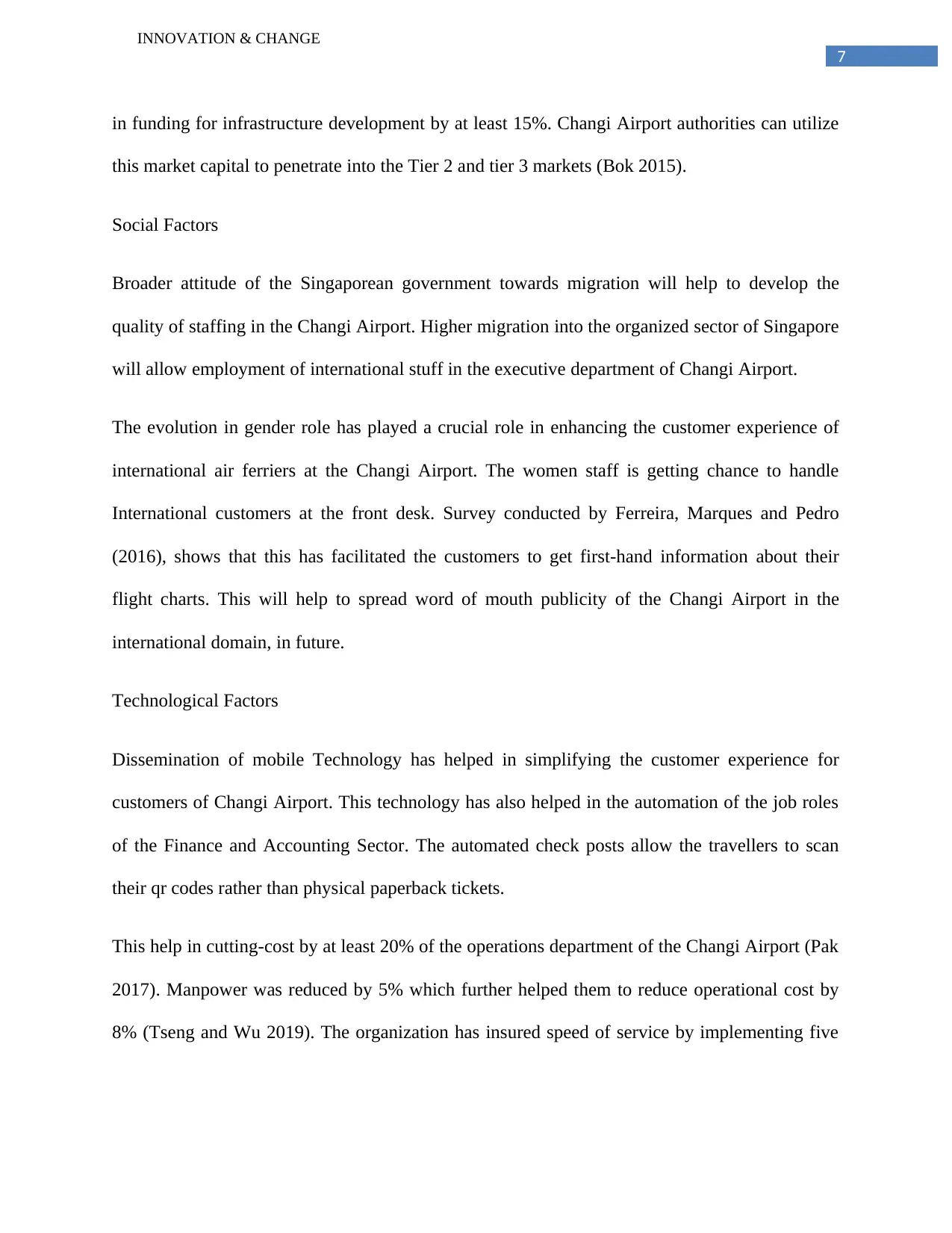
7
INNOVATION & CHANGE
in funding for infrastructure development by at least 15%. Changi Airport authorities can utilize
this market capital to penetrate into the Tier 2 and tier 3 markets (Bok 2015).
Social Factors
Broader attitude of the Singaporean government towards migration will help to develop the
quality of staffing in the Changi Airport. Higher migration into the organized sector of Singapore
will allow employment of international stuff in the executive department of Changi Airport.
The evolution in gender role has played a crucial role in enhancing the customer experience of
international air ferriers at the Changi Airport. The women staff is getting chance to handle
International customers at the front desk. Survey conducted by Ferreira, Marques and Pedro
(2016), shows that this has facilitated the customers to get first-hand information about their
flight charts. This will help to spread word of mouth publicity of the Changi Airport in the
international domain, in future.
Technological Factors
Dissemination of mobile Technology has helped in simplifying the customer experience for
customers of Changi Airport. This technology has also helped in the automation of the job roles
of the Finance and Accounting Sector. The automated check posts allow the travellers to scan
their qr codes rather than physical paperback tickets.
This help in cutting-cost by at least 20% of the operations department of the Changi Airport (Pak
2017). Manpower was reduced by 5% which further helped them to reduce operational cost by
8% (Tseng and Wu 2019). The organization has insured speed of service by implementing five
INNOVATION & CHANGE
in funding for infrastructure development by at least 15%. Changi Airport authorities can utilize
this market capital to penetrate into the Tier 2 and tier 3 markets (Bok 2015).
Social Factors
Broader attitude of the Singaporean government towards migration will help to develop the
quality of staffing in the Changi Airport. Higher migration into the organized sector of Singapore
will allow employment of international stuff in the executive department of Changi Airport.
The evolution in gender role has played a crucial role in enhancing the customer experience of
international air ferriers at the Changi Airport. The women staff is getting chance to handle
International customers at the front desk. Survey conducted by Ferreira, Marques and Pedro
(2016), shows that this has facilitated the customers to get first-hand information about their
flight charts. This will help to spread word of mouth publicity of the Changi Airport in the
international domain, in future.
Technological Factors
Dissemination of mobile Technology has helped in simplifying the customer experience for
customers of Changi Airport. This technology has also helped in the automation of the job roles
of the Finance and Accounting Sector. The automated check posts allow the travellers to scan
their qr codes rather than physical paperback tickets.
This help in cutting-cost by at least 20% of the operations department of the Changi Airport (Pak
2017). Manpower was reduced by 5% which further helped them to reduce operational cost by
8% (Tseng and Wu 2019). The organization has insured speed of service by implementing five
Paraphrase This Document
Need a fresh take? Get an instant paraphrase of this document with our AI Paraphraser
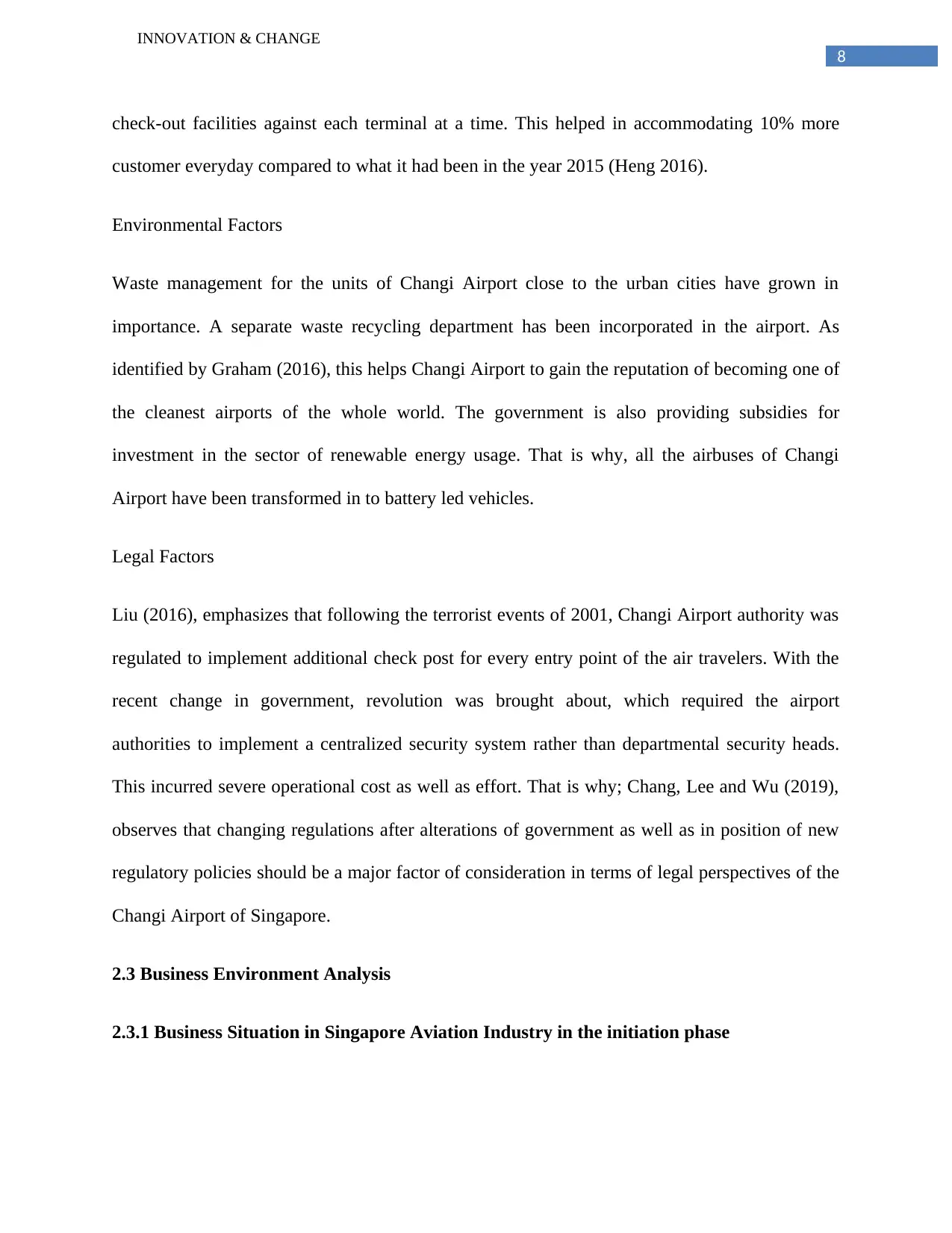
8
INNOVATION & CHANGE
check-out facilities against each terminal at a time. This helped in accommodating 10% more
customer everyday compared to what it had been in the year 2015 (Heng 2016).
Environmental Factors
Waste management for the units of Changi Airport close to the urban cities have grown in
importance. A separate waste recycling department has been incorporated in the airport. As
identified by Graham (2016), this helps Changi Airport to gain the reputation of becoming one of
the cleanest airports of the whole world. The government is also providing subsidies for
investment in the sector of renewable energy usage. That is why, all the airbuses of Changi
Airport have been transformed in to battery led vehicles.
Legal Factors
Liu (2016), emphasizes that following the terrorist events of 2001, Changi Airport authority was
regulated to implement additional check post for every entry point of the air travelers. With the
recent change in government, revolution was brought about, which required the airport
authorities to implement a centralized security system rather than departmental security heads.
This incurred severe operational cost as well as effort. That is why; Chang, Lee and Wu (2019),
observes that changing regulations after alterations of government as well as in position of new
regulatory policies should be a major factor of consideration in terms of legal perspectives of the
Changi Airport of Singapore.
2.3 Business Environment Analysis
2.3.1 Business Situation in Singapore Aviation Industry in the initiation phase
INNOVATION & CHANGE
check-out facilities against each terminal at a time. This helped in accommodating 10% more
customer everyday compared to what it had been in the year 2015 (Heng 2016).
Environmental Factors
Waste management for the units of Changi Airport close to the urban cities have grown in
importance. A separate waste recycling department has been incorporated in the airport. As
identified by Graham (2016), this helps Changi Airport to gain the reputation of becoming one of
the cleanest airports of the whole world. The government is also providing subsidies for
investment in the sector of renewable energy usage. That is why, all the airbuses of Changi
Airport have been transformed in to battery led vehicles.
Legal Factors
Liu (2016), emphasizes that following the terrorist events of 2001, Changi Airport authority was
regulated to implement additional check post for every entry point of the air travelers. With the
recent change in government, revolution was brought about, which required the airport
authorities to implement a centralized security system rather than departmental security heads.
This incurred severe operational cost as well as effort. That is why; Chang, Lee and Wu (2019),
observes that changing regulations after alterations of government as well as in position of new
regulatory policies should be a major factor of consideration in terms of legal perspectives of the
Changi Airport of Singapore.
2.3 Business Environment Analysis
2.3.1 Business Situation in Singapore Aviation Industry in the initiation phase
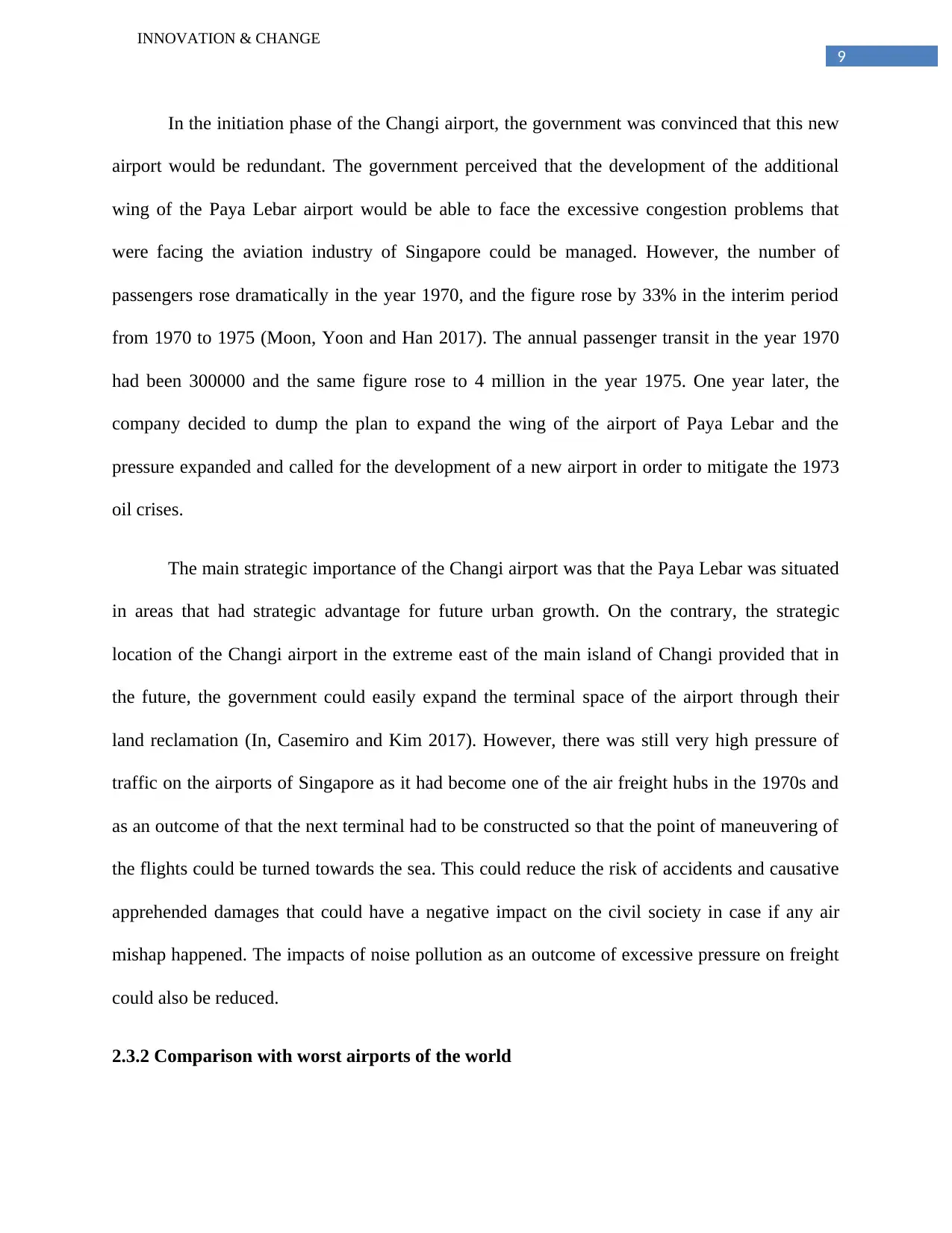
9
INNOVATION & CHANGE
In the initiation phase of the Changi airport, the government was convinced that this new
airport would be redundant. The government perceived that the development of the additional
wing of the Paya Lebar airport would be able to face the excessive congestion problems that
were facing the aviation industry of Singapore could be managed. However, the number of
passengers rose dramatically in the year 1970, and the figure rose by 33% in the interim period
from 1970 to 1975 (Moon, Yoon and Han 2017). The annual passenger transit in the year 1970
had been 300000 and the same figure rose to 4 million in the year 1975. One year later, the
company decided to dump the plan to expand the wing of the airport of Paya Lebar and the
pressure expanded and called for the development of a new airport in order to mitigate the 1973
oil crises.
The main strategic importance of the Changi airport was that the Paya Lebar was situated
in areas that had strategic advantage for future urban growth. On the contrary, the strategic
location of the Changi airport in the extreme east of the main island of Changi provided that in
the future, the government could easily expand the terminal space of the airport through their
land reclamation (In, Casemiro and Kim 2017). However, there was still very high pressure of
traffic on the airports of Singapore as it had become one of the air freight hubs in the 1970s and
as an outcome of that the next terminal had to be constructed so that the point of maneuvering of
the flights could be turned towards the sea. This could reduce the risk of accidents and causative
apprehended damages that could have a negative impact on the civil society in case if any air
mishap happened. The impacts of noise pollution as an outcome of excessive pressure on freight
could also be reduced.
2.3.2 Comparison with worst airports of the world
INNOVATION & CHANGE
In the initiation phase of the Changi airport, the government was convinced that this new
airport would be redundant. The government perceived that the development of the additional
wing of the Paya Lebar airport would be able to face the excessive congestion problems that
were facing the aviation industry of Singapore could be managed. However, the number of
passengers rose dramatically in the year 1970, and the figure rose by 33% in the interim period
from 1970 to 1975 (Moon, Yoon and Han 2017). The annual passenger transit in the year 1970
had been 300000 and the same figure rose to 4 million in the year 1975. One year later, the
company decided to dump the plan to expand the wing of the airport of Paya Lebar and the
pressure expanded and called for the development of a new airport in order to mitigate the 1973
oil crises.
The main strategic importance of the Changi airport was that the Paya Lebar was situated
in areas that had strategic advantage for future urban growth. On the contrary, the strategic
location of the Changi airport in the extreme east of the main island of Changi provided that in
the future, the government could easily expand the terminal space of the airport through their
land reclamation (In, Casemiro and Kim 2017). However, there was still very high pressure of
traffic on the airports of Singapore as it had become one of the air freight hubs in the 1970s and
as an outcome of that the next terminal had to be constructed so that the point of maneuvering of
the flights could be turned towards the sea. This could reduce the risk of accidents and causative
apprehended damages that could have a negative impact on the civil society in case if any air
mishap happened. The impacts of noise pollution as an outcome of excessive pressure on freight
could also be reduced.
2.3.2 Comparison with worst airports of the world
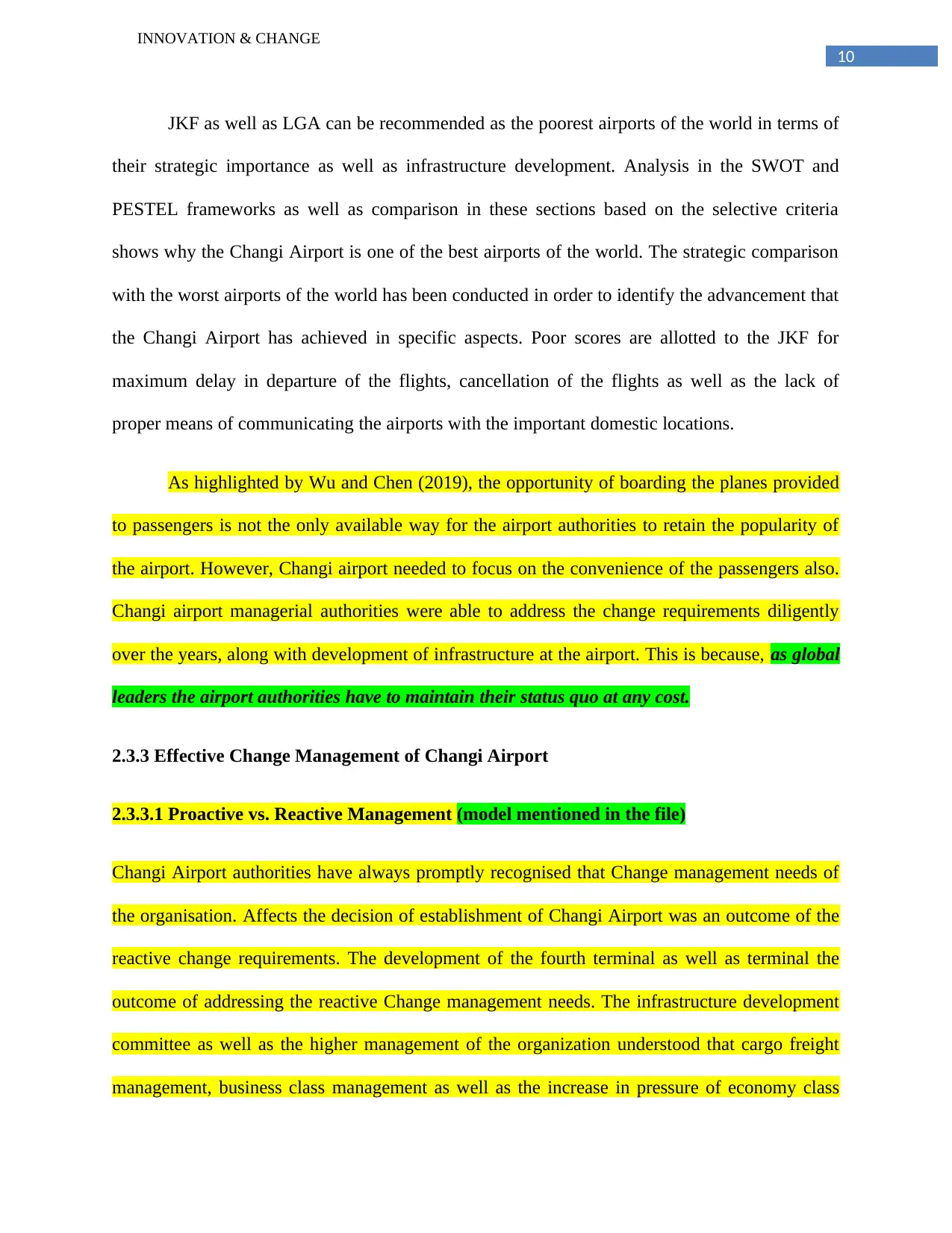
10
INNOVATION & CHANGE
JKF as well as LGA can be recommended as the poorest airports of the world in terms of
their strategic importance as well as infrastructure development. Analysis in the SWOT and
PESTEL frameworks as well as comparison in these sections based on the selective criteria
shows why the Changi Airport is one of the best airports of the world. The strategic comparison
with the worst airports of the world has been conducted in order to identify the advancement that
the Changi Airport has achieved in specific aspects. Poor scores are allotted to the JKF for
maximum delay in departure of the flights, cancellation of the flights as well as the lack of
proper means of communicating the airports with the important domestic locations.
As highlighted by Wu and Chen (2019), the opportunity of boarding the planes provided
to passengers is not the only available way for the airport authorities to retain the popularity of
the airport. However, Changi airport needed to focus on the convenience of the passengers also.
Changi airport managerial authorities were able to address the change requirements diligently
over the years, along with development of infrastructure at the airport. This is because, as global
leaders the airport authorities have to maintain their status quo at any cost.
2.3.3 Effective Change Management of Changi Airport
2.3.3.1 Proactive vs. Reactive Management (model mentioned in the file)
Changi Airport authorities have always promptly recognised that Change management needs of
the organisation. Affects the decision of establishment of Changi Airport was an outcome of the
reactive change requirements. The development of the fourth terminal as well as terminal the
outcome of addressing the reactive Change management needs. The infrastructure development
committee as well as the higher management of the organization understood that cargo freight
management, business class management as well as the increase in pressure of economy class
INNOVATION & CHANGE
JKF as well as LGA can be recommended as the poorest airports of the world in terms of
their strategic importance as well as infrastructure development. Analysis in the SWOT and
PESTEL frameworks as well as comparison in these sections based on the selective criteria
shows why the Changi Airport is one of the best airports of the world. The strategic comparison
with the worst airports of the world has been conducted in order to identify the advancement that
the Changi Airport has achieved in specific aspects. Poor scores are allotted to the JKF for
maximum delay in departure of the flights, cancellation of the flights as well as the lack of
proper means of communicating the airports with the important domestic locations.
As highlighted by Wu and Chen (2019), the opportunity of boarding the planes provided
to passengers is not the only available way for the airport authorities to retain the popularity of
the airport. However, Changi airport needed to focus on the convenience of the passengers also.
Changi airport managerial authorities were able to address the change requirements diligently
over the years, along with development of infrastructure at the airport. This is because, as global
leaders the airport authorities have to maintain their status quo at any cost.
2.3.3 Effective Change Management of Changi Airport
2.3.3.1 Proactive vs. Reactive Management (model mentioned in the file)
Changi Airport authorities have always promptly recognised that Change management needs of
the organisation. Affects the decision of establishment of Changi Airport was an outcome of the
reactive change requirements. The development of the fourth terminal as well as terminal the
outcome of addressing the reactive Change management needs. The infrastructure development
committee as well as the higher management of the organization understood that cargo freight
management, business class management as well as the increase in pressure of economy class
Secure Best Marks with AI Grader
Need help grading? Try our AI Grader for instant feedback on your assignments.
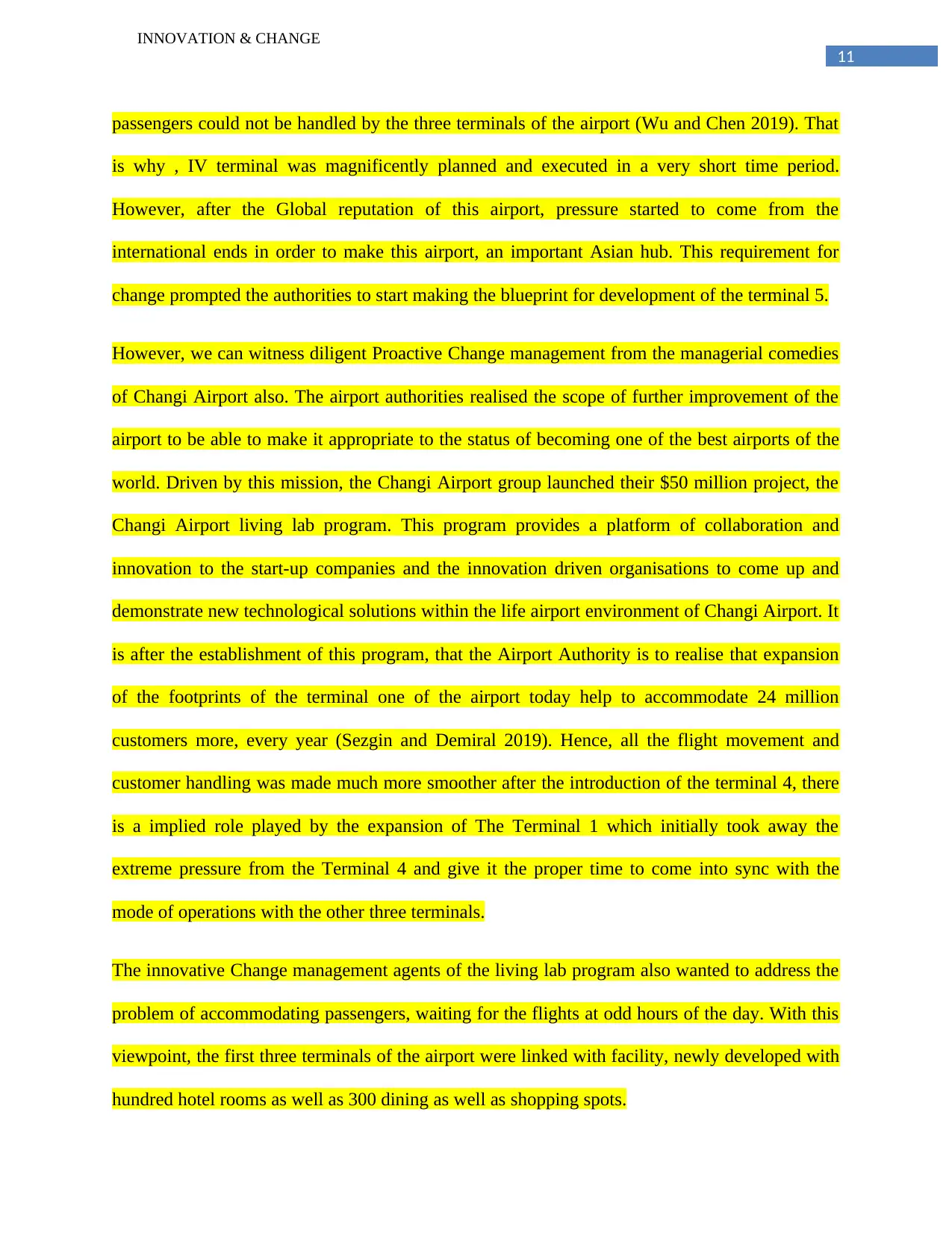
11
INNOVATION & CHANGE
passengers could not be handled by the three terminals of the airport (Wu and Chen 2019). That
is why , IV terminal was magnificently planned and executed in a very short time period.
However, after the Global reputation of this airport, pressure started to come from the
international ends in order to make this airport, an important Asian hub. This requirement for
change prompted the authorities to start making the blueprint for development of the terminal 5.
However, we can witness diligent Proactive Change management from the managerial comedies
of Changi Airport also. The airport authorities realised the scope of further improvement of the
airport to be able to make it appropriate to the status of becoming one of the best airports of the
world. Driven by this mission, the Changi Airport group launched their $50 million project, the
Changi Airport living lab program. This program provides a platform of collaboration and
innovation to the start-up companies and the innovation driven organisations to come up and
demonstrate new technological solutions within the life airport environment of Changi Airport. It
is after the establishment of this program, that the Airport Authority is to realise that expansion
of the footprints of the terminal one of the airport today help to accommodate 24 million
customers more, every year (Sezgin and Demiral 2019). Hence, all the flight movement and
customer handling was made much more smoother after the introduction of the terminal 4, there
is a implied role played by the expansion of The Terminal 1 which initially took away the
extreme pressure from the Terminal 4 and give it the proper time to come into sync with the
mode of operations with the other three terminals.
The innovative Change management agents of the living lab program also wanted to address the
problem of accommodating passengers, waiting for the flights at odd hours of the day. With this
viewpoint, the first three terminals of the airport were linked with facility, newly developed with
hundred hotel rooms as well as 300 dining as well as shopping spots.
INNOVATION & CHANGE
passengers could not be handled by the three terminals of the airport (Wu and Chen 2019). That
is why , IV terminal was magnificently planned and executed in a very short time period.
However, after the Global reputation of this airport, pressure started to come from the
international ends in order to make this airport, an important Asian hub. This requirement for
change prompted the authorities to start making the blueprint for development of the terminal 5.
However, we can witness diligent Proactive Change management from the managerial comedies
of Changi Airport also. The airport authorities realised the scope of further improvement of the
airport to be able to make it appropriate to the status of becoming one of the best airports of the
world. Driven by this mission, the Changi Airport group launched their $50 million project, the
Changi Airport living lab program. This program provides a platform of collaboration and
innovation to the start-up companies and the innovation driven organisations to come up and
demonstrate new technological solutions within the life airport environment of Changi Airport. It
is after the establishment of this program, that the Airport Authority is to realise that expansion
of the footprints of the terminal one of the airport today help to accommodate 24 million
customers more, every year (Sezgin and Demiral 2019). Hence, all the flight movement and
customer handling was made much more smoother after the introduction of the terminal 4, there
is a implied role played by the expansion of The Terminal 1 which initially took away the
extreme pressure from the Terminal 4 and give it the proper time to come into sync with the
mode of operations with the other three terminals.
The innovative Change management agents of the living lab program also wanted to address the
problem of accommodating passengers, waiting for the flights at odd hours of the day. With this
viewpoint, the first three terminals of the airport were linked with facility, newly developed with
hundred hotel rooms as well as 300 dining as well as shopping spots.
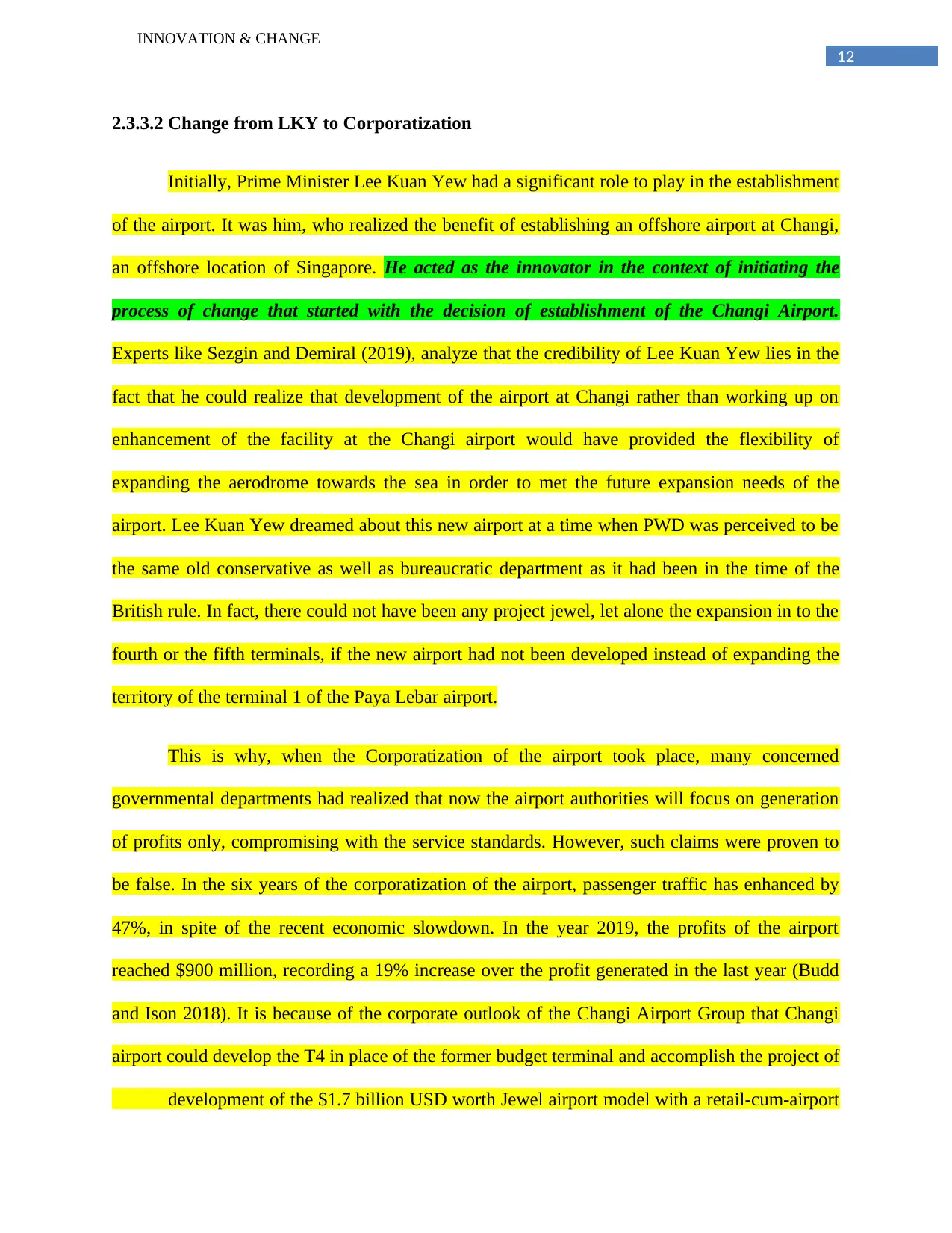
12
INNOVATION & CHANGE
2.3.3.2 Change from LKY to Corporatization
Initially, Prime Minister Lee Kuan Yew had a significant role to play in the establishment
of the airport. It was him, who realized the benefit of establishing an offshore airport at Changi,
an offshore location of Singapore. He acted as the innovator in the context of initiating the
process of change that started with the decision of establishment of the Changi Airport.
Experts like Sezgin and Demiral (2019), analyze that the credibility of Lee Kuan Yew lies in the
fact that he could realize that development of the airport at Changi rather than working up on
enhancement of the facility at the Changi airport would have provided the flexibility of
expanding the aerodrome towards the sea in order to met the future expansion needs of the
airport. Lee Kuan Yew dreamed about this new airport at a time when PWD was perceived to be
the same old conservative as well as bureaucratic department as it had been in the time of the
British rule. In fact, there could not have been any project jewel, let alone the expansion in to the
fourth or the fifth terminals, if the new airport had not been developed instead of expanding the
territory of the terminal 1 of the Paya Lebar airport.
This is why, when the Corporatization of the airport took place, many concerned
governmental departments had realized that now the airport authorities will focus on generation
of profits only, compromising with the service standards. However, such claims were proven to
be false. In the six years of the corporatization of the airport, passenger traffic has enhanced by
47%, in spite of the recent economic slowdown. In the year 2019, the profits of the airport
reached $900 million, recording a 19% increase over the profit generated in the last year (Budd
and Ison 2018). It is because of the corporate outlook of the Changi Airport Group that Changi
airport could develop the T4 in place of the former budget terminal and accomplish the project of
development of the $1.7 billion USD worth Jewel airport model with a retail-cum-airport
INNOVATION & CHANGE
2.3.3.2 Change from LKY to Corporatization
Initially, Prime Minister Lee Kuan Yew had a significant role to play in the establishment
of the airport. It was him, who realized the benefit of establishing an offshore airport at Changi,
an offshore location of Singapore. He acted as the innovator in the context of initiating the
process of change that started with the decision of establishment of the Changi Airport.
Experts like Sezgin and Demiral (2019), analyze that the credibility of Lee Kuan Yew lies in the
fact that he could realize that development of the airport at Changi rather than working up on
enhancement of the facility at the Changi airport would have provided the flexibility of
expanding the aerodrome towards the sea in order to met the future expansion needs of the
airport. Lee Kuan Yew dreamed about this new airport at a time when PWD was perceived to be
the same old conservative as well as bureaucratic department as it had been in the time of the
British rule. In fact, there could not have been any project jewel, let alone the expansion in to the
fourth or the fifth terminals, if the new airport had not been developed instead of expanding the
territory of the terminal 1 of the Paya Lebar airport.
This is why, when the Corporatization of the airport took place, many concerned
governmental departments had realized that now the airport authorities will focus on generation
of profits only, compromising with the service standards. However, such claims were proven to
be false. In the six years of the corporatization of the airport, passenger traffic has enhanced by
47%, in spite of the recent economic slowdown. In the year 2019, the profits of the airport
reached $900 million, recording a 19% increase over the profit generated in the last year (Budd
and Ison 2018). It is because of the corporate outlook of the Changi Airport Group that Changi
airport could develop the T4 in place of the former budget terminal and accomplish the project of
development of the $1.7 billion USD worth Jewel airport model with a retail-cum-airport
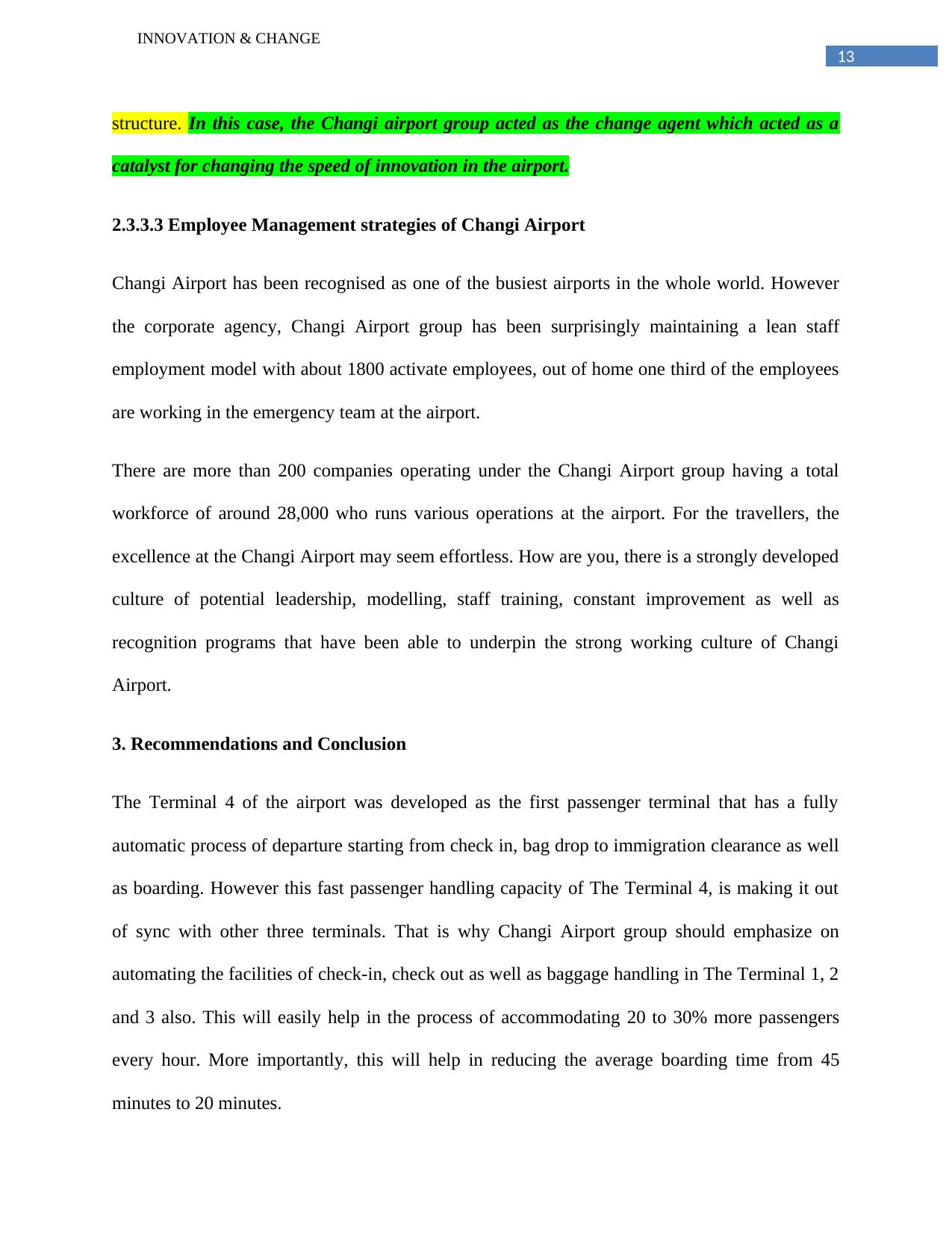
13
INNOVATION & CHANGE
structure. In this case, the Changi airport group acted as the change agent which acted as a
catalyst for changing the speed of innovation in the airport.
2.3.3.3 Employee Management strategies of Changi Airport
Changi Airport has been recognised as one of the busiest airports in the whole world. However
the corporate agency, Changi Airport group has been surprisingly maintaining a lean staff
employment model with about 1800 activate employees, out of home one third of the employees
are working in the emergency team at the airport.
There are more than 200 companies operating under the Changi Airport group having a total
workforce of around 28,000 who runs various operations at the airport. For the travellers, the
excellence at the Changi Airport may seem effortless. How are you, there is a strongly developed
culture of potential leadership, modelling, staff training, constant improvement as well as
recognition programs that have been able to underpin the strong working culture of Changi
Airport.
3. Recommendations and Conclusion
The Terminal 4 of the airport was developed as the first passenger terminal that has a fully
automatic process of departure starting from check in, bag drop to immigration clearance as well
as boarding. However this fast passenger handling capacity of The Terminal 4, is making it out
of sync with other three terminals. That is why Changi Airport group should emphasize on
automating the facilities of check-in, check out as well as baggage handling in The Terminal 1, 2
and 3 also. This will easily help in the process of accommodating 20 to 30% more passengers
every hour. More importantly, this will help in reducing the average boarding time from 45
minutes to 20 minutes.
INNOVATION & CHANGE
structure. In this case, the Changi airport group acted as the change agent which acted as a
catalyst for changing the speed of innovation in the airport.
2.3.3.3 Employee Management strategies of Changi Airport
Changi Airport has been recognised as one of the busiest airports in the whole world. However
the corporate agency, Changi Airport group has been surprisingly maintaining a lean staff
employment model with about 1800 activate employees, out of home one third of the employees
are working in the emergency team at the airport.
There are more than 200 companies operating under the Changi Airport group having a total
workforce of around 28,000 who runs various operations at the airport. For the travellers, the
excellence at the Changi Airport may seem effortless. How are you, there is a strongly developed
culture of potential leadership, modelling, staff training, constant improvement as well as
recognition programs that have been able to underpin the strong working culture of Changi
Airport.
3. Recommendations and Conclusion
The Terminal 4 of the airport was developed as the first passenger terminal that has a fully
automatic process of departure starting from check in, bag drop to immigration clearance as well
as boarding. However this fast passenger handling capacity of The Terminal 4, is making it out
of sync with other three terminals. That is why Changi Airport group should emphasize on
automating the facilities of check-in, check out as well as baggage handling in The Terminal 1, 2
and 3 also. This will easily help in the process of accommodating 20 to 30% more passengers
every hour. More importantly, this will help in reducing the average boarding time from 45
minutes to 20 minutes.
Paraphrase This Document
Need a fresh take? Get an instant paraphrase of this document with our AI Paraphraser
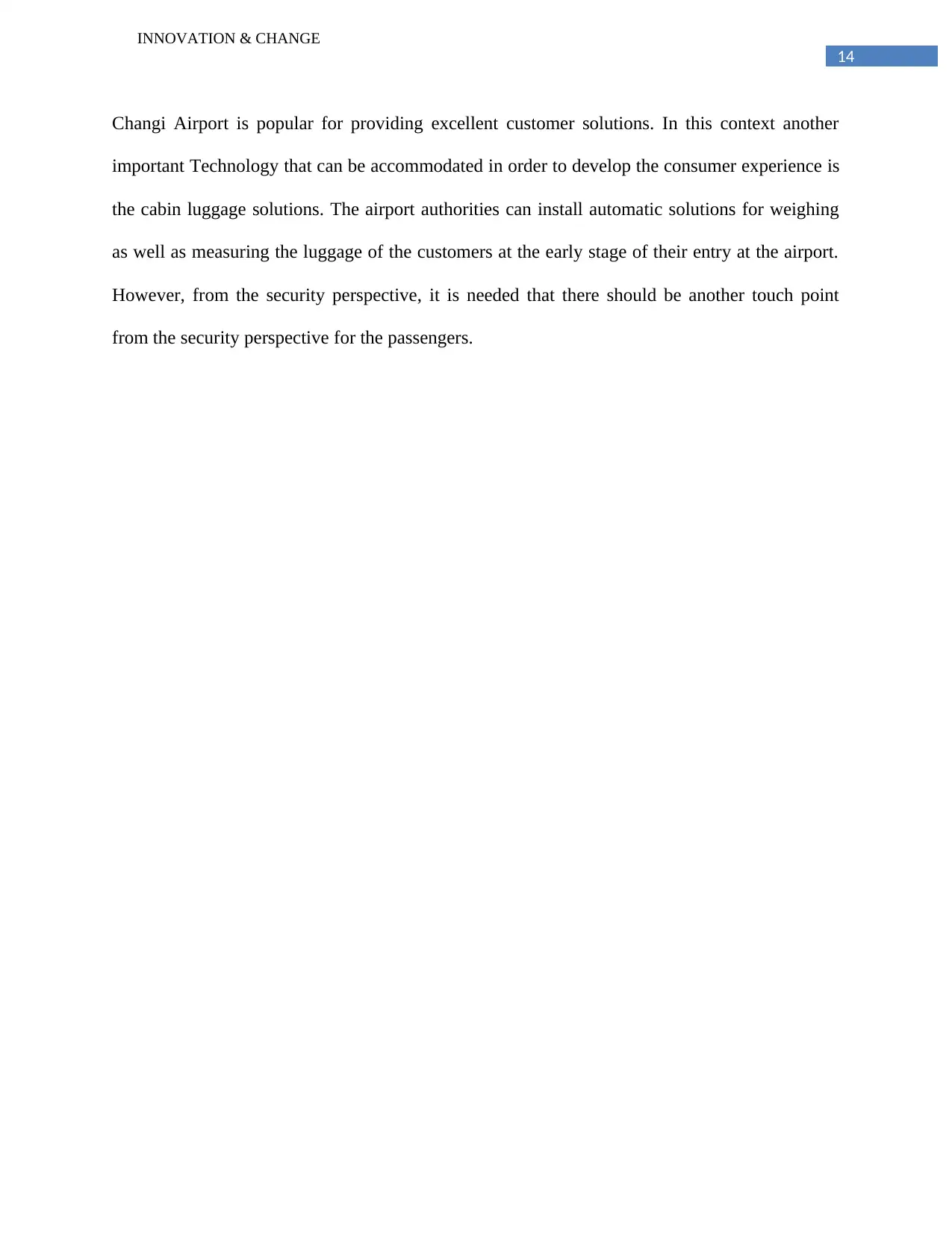
14
INNOVATION & CHANGE
Changi Airport is popular for providing excellent customer solutions. In this context another
important Technology that can be accommodated in order to develop the consumer experience is
the cabin luggage solutions. The airport authorities can install automatic solutions for weighing
as well as measuring the luggage of the customers at the early stage of their entry at the airport.
However, from the security perspective, it is needed that there should be another touch point
from the security perspective for the passengers.
INNOVATION & CHANGE
Changi Airport is popular for providing excellent customer solutions. In this context another
important Technology that can be accommodated in order to develop the consumer experience is
the cabin luggage solutions. The airport authorities can install automatic solutions for weighing
as well as measuring the luggage of the customers at the early stage of their entry at the airport.
However, from the security perspective, it is needed that there should be another touch point
from the security perspective for the passengers.
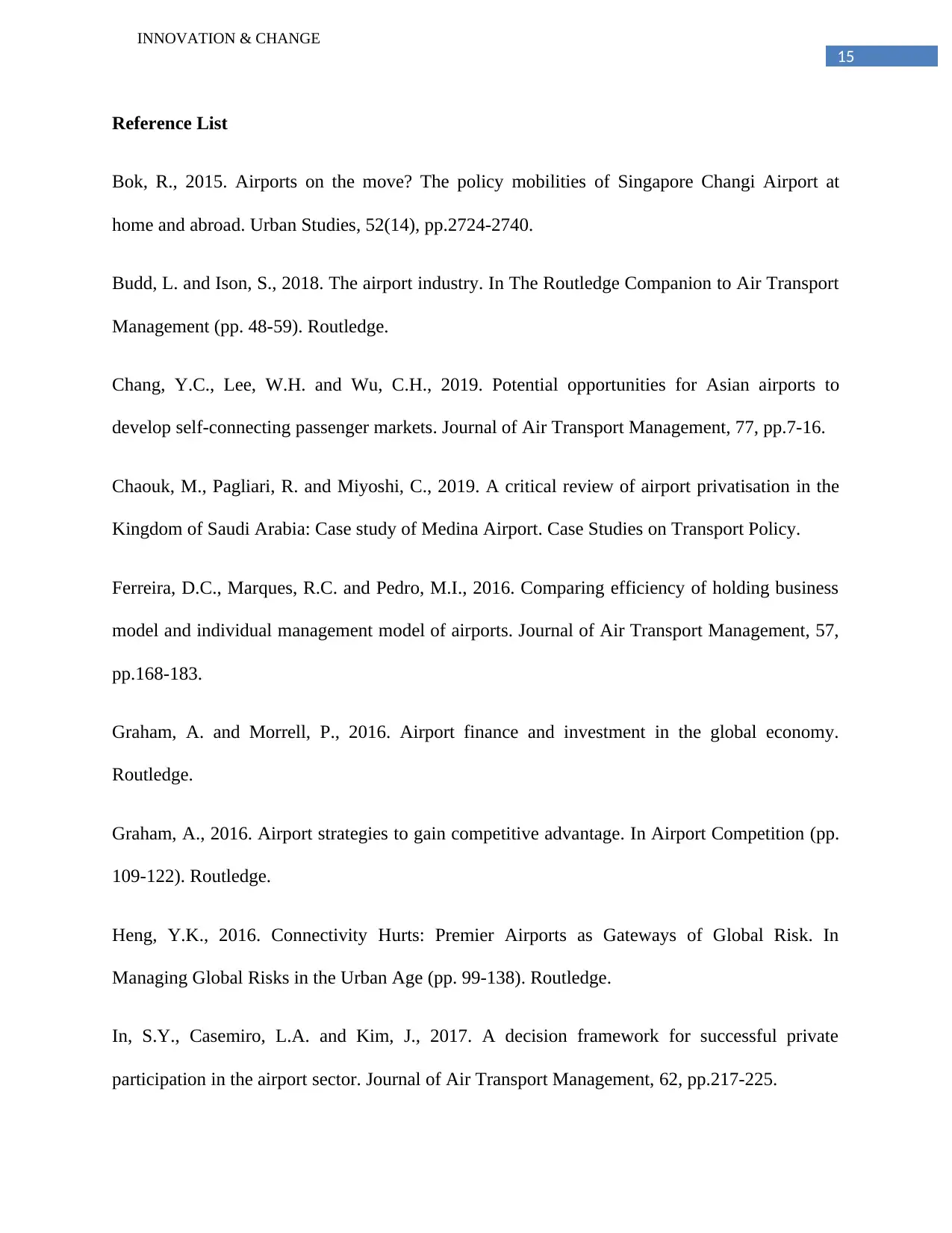
15
INNOVATION & CHANGE
Reference List
Bok, R., 2015. Airports on the move? The policy mobilities of Singapore Changi Airport at
home and abroad. Urban Studies, 52(14), pp.2724-2740.
Budd, L. and Ison, S., 2018. The airport industry. In The Routledge Companion to Air Transport
Management (pp. 48-59). Routledge.
Chang, Y.C., Lee, W.H. and Wu, C.H., 2019. Potential opportunities for Asian airports to
develop self-connecting passenger markets. Journal of Air Transport Management, 77, pp.7-16.
Chaouk, M., Pagliari, R. and Miyoshi, C., 2019. A critical review of airport privatisation in the
Kingdom of Saudi Arabia: Case study of Medina Airport. Case Studies on Transport Policy.
Ferreira, D.C., Marques, R.C. and Pedro, M.I., 2016. Comparing efficiency of holding business
model and individual management model of airports. Journal of Air Transport Management, 57,
pp.168-183.
Graham, A. and Morrell, P., 2016. Airport finance and investment in the global economy.
Routledge.
Graham, A., 2016. Airport strategies to gain competitive advantage. In Airport Competition (pp.
109-122). Routledge.
Heng, Y.K., 2016. Connectivity Hurts: Premier Airports as Gateways of Global Risk. In
Managing Global Risks in the Urban Age (pp. 99-138). Routledge.
In, S.Y., Casemiro, L.A. and Kim, J., 2017. A decision framework for successful private
participation in the airport sector. Journal of Air Transport Management, 62, pp.217-225.
INNOVATION & CHANGE
Reference List
Bok, R., 2015. Airports on the move? The policy mobilities of Singapore Changi Airport at
home and abroad. Urban Studies, 52(14), pp.2724-2740.
Budd, L. and Ison, S., 2018. The airport industry. In The Routledge Companion to Air Transport
Management (pp. 48-59). Routledge.
Chang, Y.C., Lee, W.H. and Wu, C.H., 2019. Potential opportunities for Asian airports to
develop self-connecting passenger markets. Journal of Air Transport Management, 77, pp.7-16.
Chaouk, M., Pagliari, R. and Miyoshi, C., 2019. A critical review of airport privatisation in the
Kingdom of Saudi Arabia: Case study of Medina Airport. Case Studies on Transport Policy.
Ferreira, D.C., Marques, R.C. and Pedro, M.I., 2016. Comparing efficiency of holding business
model and individual management model of airports. Journal of Air Transport Management, 57,
pp.168-183.
Graham, A. and Morrell, P., 2016. Airport finance and investment in the global economy.
Routledge.
Graham, A., 2016. Airport strategies to gain competitive advantage. In Airport Competition (pp.
109-122). Routledge.
Heng, Y.K., 2016. Connectivity Hurts: Premier Airports as Gateways of Global Risk. In
Managing Global Risks in the Urban Age (pp. 99-138). Routledge.
In, S.Y., Casemiro, L.A. and Kim, J., 2017. A decision framework for successful private
participation in the airport sector. Journal of Air Transport Management, 62, pp.217-225.
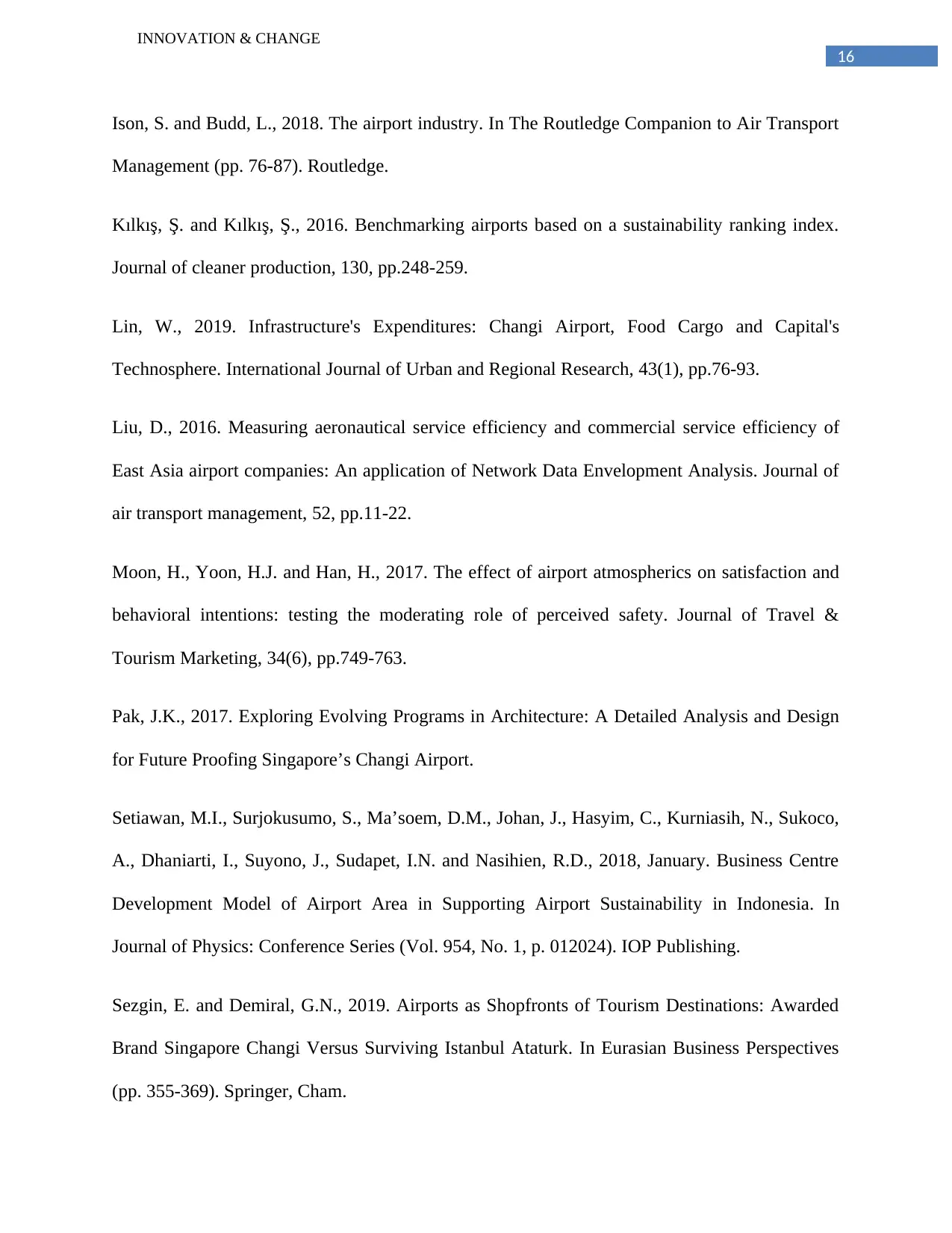
16
INNOVATION & CHANGE
Ison, S. and Budd, L., 2018. The airport industry. In The Routledge Companion to Air Transport
Management (pp. 76-87). Routledge.
Kılkış, Ş. and Kılkış, Ş., 2016. Benchmarking airports based on a sustainability ranking index.
Journal of cleaner production, 130, pp.248-259.
Lin, W., 2019. Infrastructure's Expenditures: Changi Airport, Food Cargo and Capital's
Technosphere. International Journal of Urban and Regional Research, 43(1), pp.76-93.
Liu, D., 2016. Measuring aeronautical service efficiency and commercial service efficiency of
East Asia airport companies: An application of Network Data Envelopment Analysis. Journal of
air transport management, 52, pp.11-22.
Moon, H., Yoon, H.J. and Han, H., 2017. The effect of airport atmospherics on satisfaction and
behavioral intentions: testing the moderating role of perceived safety. Journal of Travel &
Tourism Marketing, 34(6), pp.749-763.
Pak, J.K., 2017. Exploring Evolving Programs in Architecture: A Detailed Analysis and Design
for Future Proofing Singapore’s Changi Airport.
Setiawan, M.I., Surjokusumo, S., Ma’soem, D.M., Johan, J., Hasyim, C., Kurniasih, N., Sukoco,
A., Dhaniarti, I., Suyono, J., Sudapet, I.N. and Nasihien, R.D., 2018, January. Business Centre
Development Model of Airport Area in Supporting Airport Sustainability in Indonesia. In
Journal of Physics: Conference Series (Vol. 954, No. 1, p. 012024). IOP Publishing.
Sezgin, E. and Demiral, G.N., 2019. Airports as Shopfronts of Tourism Destinations: Awarded
Brand Singapore Changi Versus Surviving Istanbul Ataturk. In Eurasian Business Perspectives
(pp. 355-369). Springer, Cham.
INNOVATION & CHANGE
Ison, S. and Budd, L., 2018. The airport industry. In The Routledge Companion to Air Transport
Management (pp. 76-87). Routledge.
Kılkış, Ş. and Kılkış, Ş., 2016. Benchmarking airports based on a sustainability ranking index.
Journal of cleaner production, 130, pp.248-259.
Lin, W., 2019. Infrastructure's Expenditures: Changi Airport, Food Cargo and Capital's
Technosphere. International Journal of Urban and Regional Research, 43(1), pp.76-93.
Liu, D., 2016. Measuring aeronautical service efficiency and commercial service efficiency of
East Asia airport companies: An application of Network Data Envelopment Analysis. Journal of
air transport management, 52, pp.11-22.
Moon, H., Yoon, H.J. and Han, H., 2017. The effect of airport atmospherics on satisfaction and
behavioral intentions: testing the moderating role of perceived safety. Journal of Travel &
Tourism Marketing, 34(6), pp.749-763.
Pak, J.K., 2017. Exploring Evolving Programs in Architecture: A Detailed Analysis and Design
for Future Proofing Singapore’s Changi Airport.
Setiawan, M.I., Surjokusumo, S., Ma’soem, D.M., Johan, J., Hasyim, C., Kurniasih, N., Sukoco,
A., Dhaniarti, I., Suyono, J., Sudapet, I.N. and Nasihien, R.D., 2018, January. Business Centre
Development Model of Airport Area in Supporting Airport Sustainability in Indonesia. In
Journal of Physics: Conference Series (Vol. 954, No. 1, p. 012024). IOP Publishing.
Sezgin, E. and Demiral, G.N., 2019. Airports as Shopfronts of Tourism Destinations: Awarded
Brand Singapore Changi Versus Surviving Istanbul Ataturk. In Eurasian Business Perspectives
(pp. 355-369). Springer, Cham.
Secure Best Marks with AI Grader
Need help grading? Try our AI Grader for instant feedback on your assignments.
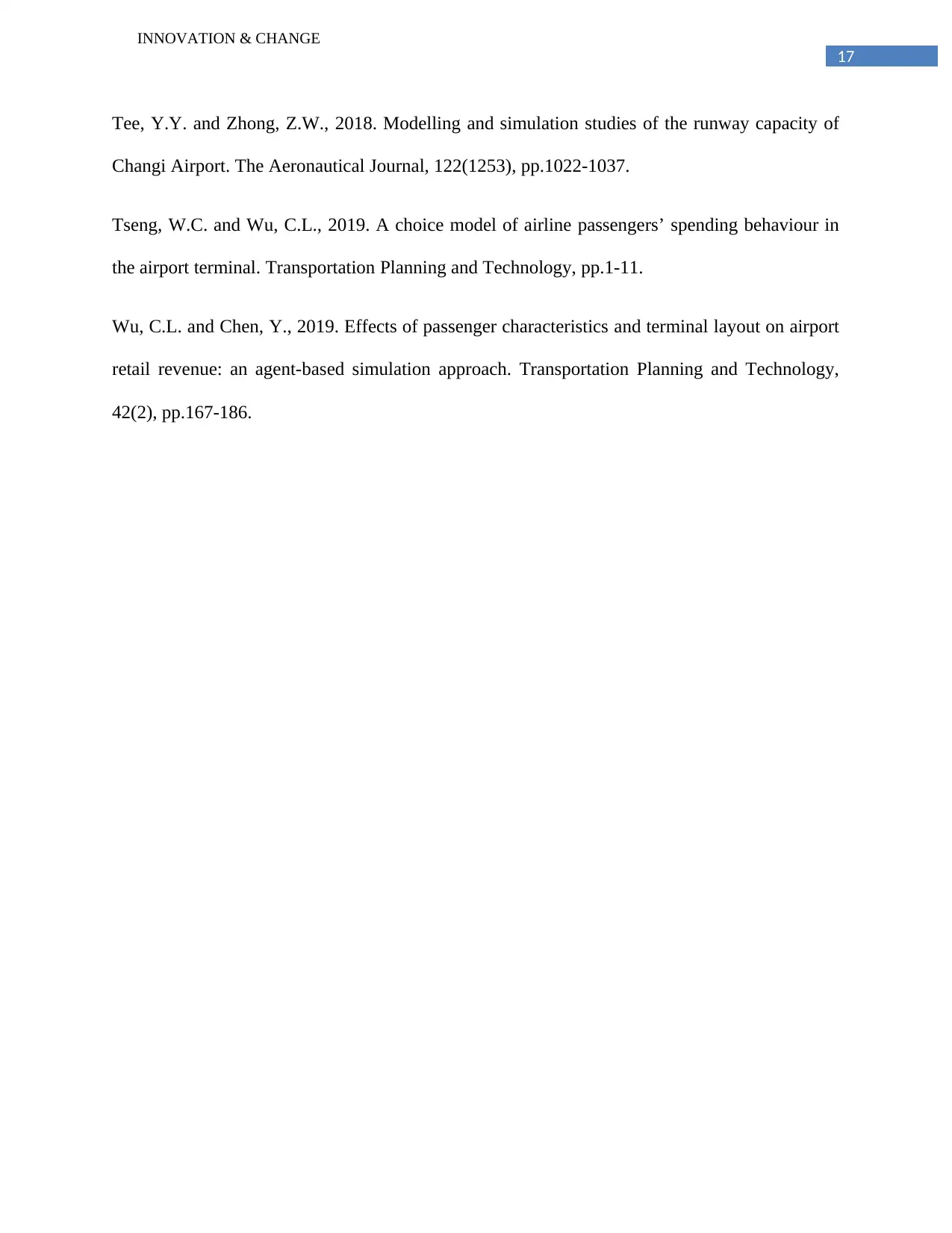
17
INNOVATION & CHANGE
Tee, Y.Y. and Zhong, Z.W., 2018. Modelling and simulation studies of the runway capacity of
Changi Airport. The Aeronautical Journal, 122(1253), pp.1022-1037.
Tseng, W.C. and Wu, C.L., 2019. A choice model of airline passengers’ spending behaviour in
the airport terminal. Transportation Planning and Technology, pp.1-11.
Wu, C.L. and Chen, Y., 2019. Effects of passenger characteristics and terminal layout on airport
retail revenue: an agent-based simulation approach. Transportation Planning and Technology,
42(2), pp.167-186.
INNOVATION & CHANGE
Tee, Y.Y. and Zhong, Z.W., 2018. Modelling and simulation studies of the runway capacity of
Changi Airport. The Aeronautical Journal, 122(1253), pp.1022-1037.
Tseng, W.C. and Wu, C.L., 2019. A choice model of airline passengers’ spending behaviour in
the airport terminal. Transportation Planning and Technology, pp.1-11.
Wu, C.L. and Chen, Y., 2019. Effects of passenger characteristics and terminal layout on airport
retail revenue: an agent-based simulation approach. Transportation Planning and Technology,
42(2), pp.167-186.
1 out of 17
Your All-in-One AI-Powered Toolkit for Academic Success.
+13062052269
info@desklib.com
Available 24*7 on WhatsApp / Email
![[object Object]](/_next/static/media/star-bottom.7253800d.svg)
Unlock your academic potential
© 2024 | Zucol Services PVT LTD | All rights reserved.





